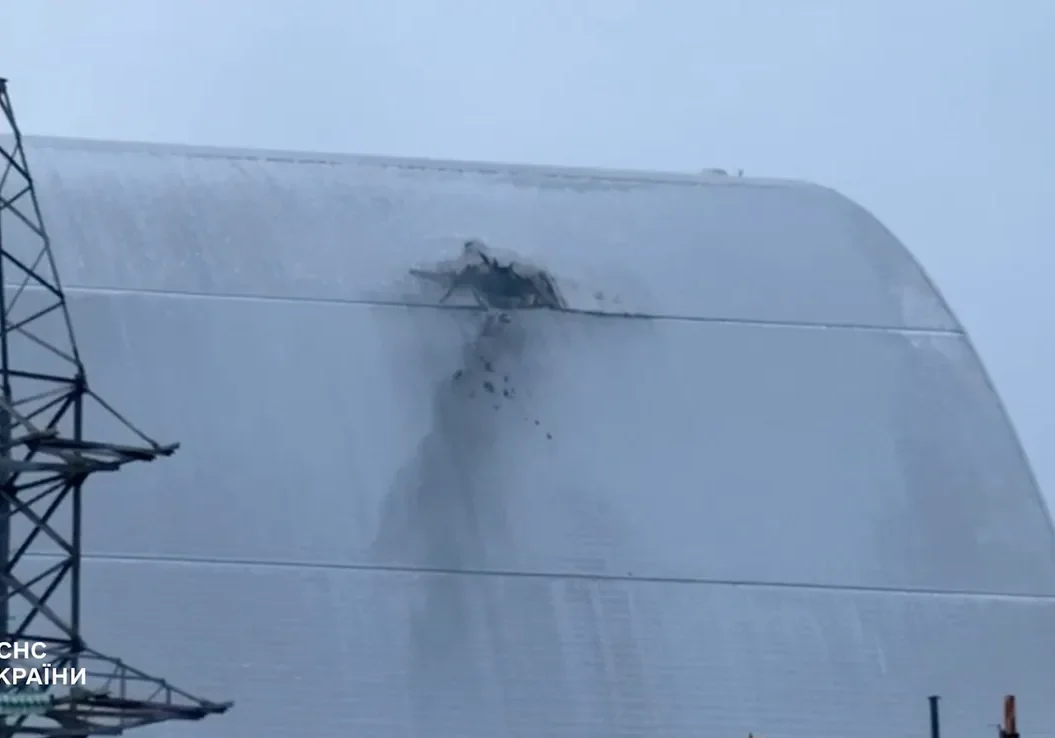How a Cheap Drone Punctured Chernobyl’s 40,000-Ton Shield

[Photo: Still image/screen grab taken from a handout video provided by the UKRAINIAN PRESIDENTIAL PRESS SERVICE]
The steel shell that encloses the site of the world’s worst nuclear disaster was built to endure for a century. But war was a scenario its engineers never envisioned.
As reported by Kim Barker in the New York Times, with photographs by Brendan Hoffman. (Hoffman previously worked at Public Citizen’s Critical Mass Energy Project in Washington, D.C.)
The article cites and quotes Greenpeace International:
“The reason the international community spent so much money and time building this structure is because they know the scale of the threat radiologically inside,” said Shaun Burnie, a nuclear specialist at Greenpeace who visited the damaged reactor at Chernobyl after the drone attack.
“It’s an enormous intellectual achievement to build something that could protect Europe, Ukraine and the world from what’s inside,” he said. “And now the Russians have basically blown a hole in it, both physically and metaphorically.”
On Thursday, Greenpeace released a report saying the drone attack severely compromised plans for the damaged reactor and that the shell was no longer functioning as designed. Jan Vande Putte, a nuclear specialist at Greenpeace Ukraine, said the entire shell might have to be removed, dismantled and replaced — a view echoed by Mr. Schmieman [a civil engineer and senior technical adviser on the Chornobyl shell for 15 years] and Mr. Siryi [the head of the operations department for the structure, called the New Safe Confinement]. The I.A.E.A. said the shell’s confinement function had been compromised and that the structure needed “extensive repair efforts.”
Although the shell’s designers may not have considered the risks of military attacks, others did foresee such threats. For example, Dr. Bennett Ramberg published Nuclear Power Plants as Weapons for the Enemy: An Unrecognized Military Peril in the 1980s. His book was recently republished by the University of California Press.
The New York Times article reports:
The explosion’s official death toll was 31. But many other people got sick or eventually died. Cancer rates, especially for thyroid cancer, increased in areas heavily exposed to radiation.
By the 20th annual commemoration of the Chornobyl nuclear catastrophe (Chornobyl is the anglicized Ukrainian spelling; Chernobyl is the anglicized Russian spelling), the United Nations actually acknowledged that more than 4,000 people would eventually die, over time, due to their exposure to radioactivity from the disaster.
However, Dr. Ian Fairlie, in his 2006 TORCH Report (The Other Chernobyl Report), put the figure at more than 90,000.
Yablokov, Nesterenko, and Nesterenko, in their survey of Belarussian, Russian, and Ukrainian scientific studies, put the Chornobyl death figure at nearly one million, just from 1986 to 2004. Their 2007 book, Chernobyl: Consequences of the Catastrophe for People and the Environment, was published in English by the New York Academy of Science Press in 2009.
Support Beyond Nuclear
Help to ensure a safer, greener and more just world for all

